Tips for Preventing Ankle Sprains and Chronic Instability
Ankle sprains are common injuries, occurring in about 25,000 patients each day . A sprain occurs when one or more of the supporting structures (ligaments) on the outside of the ankle become damaged, weakened or torn. Ligaments are tight bands that help to hold bones in their normal position. On the outside of the ankle there are three that are responsible for stabilizing the ankle joint: the anterior talofibular ligament (ATFL), the calcaneofibular ligament (CFL), and the posterior talofibular ligament (PTFL).
How does Ankle Instability Occur?
Chronic instability happens when the ankle gives out easily or unexpectedly due to weakening of one or more of these three stabilizing ligaments. When they are repeatedly damaged or if one of them fails to heal properly, the result is a loose ankle joint that can swell, hurt and roll out of position easily and often.
How can Chronic Ankle Instability be Prevented?
A component of ankle instability and ligament damage is usually one or more undertreated, significant sprains. Being patient and taking your time recovering from a sprain is critical in avoiding future ankle instability. Here are some tips that will help:
Allow the acute swelling and pain to resolve - Immediately after a significant sprain RIICE (rest, ice, immobilization, compression and elevation) is helpful for proper healing and allowing the injured ankle to cool down. Wait until the early swelling and pain have subsided before resuming physical activity. Ice packs, ACE bandages and over-the-counter ankle braces are also helpful and readily available.
Restore normal range of motion - Home exercises and even formal physical therapy help get the injured ankle joint moving again. Attempting to return to physical activity before normal range of motion is restored often leads to improper function and can prevent the ankle ligaments from healing properly. This can also lead to abnormal compensation by the foot and lower leg, creating injuries to other areas of the body. I see this frequently with dancers and basketball players. Their ankles are vulnerable to injury, but they are motivated to return too early because of an upcoming recital or game.
Rebuilding normal strength -
In addition to the three supporting
ligaments, tendons also help to support the ankle joint. Tendons differ from
ligaments in that they are dynamic stabilizers of the ankle joint. Tendons move
and glide; they contract and pull to help move bones for normal function.
Simple exercises can help to build strength in the ankle and tendons:
- Balance exercises
– These are easy to perform and do not require
special equipment. Standing on one leg for 30 seconds is a good start.
One-legged squats add a little difficulty. These can be done for five to ten
repetitions in sets of two to three.
- Side-to-side lunges – These help to stretch and to strengthen. Adding an elastic band makes this more challenging. Reps of five to ten in each direction helps to balance the range of motion and strength to both lower legs.
- Calf raises - These help to stretch the back of the ankle and build strength as well. All you need is a low step or ledge. Performing these single or double legged helps to add or reduce resistance.
- Elastic bands – These are inexpensive and useful for resistance training. Capital letters of the alphabet is a commonly recommended exercise for building ankle strength. If that is too challenging at first, simple up and down movement (dorsiflexion and plantarflexion) can be a good start.
Ankle sprains are common, but not allowing a sprain to heal properly or suffering multiple injuries can result in chronic ankle instability down the road. Use these tips to help protect your ankle from future injuries and to fully rehabilitate it should a sprain or other injury occur.
If you are suffering from frequent ankle sprains or other signs of chronic ankle instability, contact my office to request an appointment . Together, we can work to fully heal any existing injuries, as well as build your ankle strength and safeguard it from future problems.


